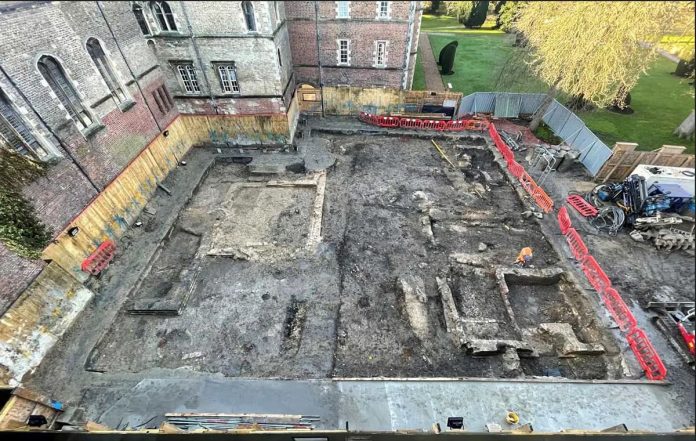Main Image: An aerial view of the site, taken from the roof of the college. The modern topsoil and garden paths have been removed using a machine, to reveal the remains of Alfred Waterhouse’s 19th century building, visible in the top-left corner, the cellars and walls of a 17th century building visible in the bottom-right corner, and dark post-medieval soil layers in between. - Cotswold Archaeology
Cotswold Archaeology, with assistance from the Cambridge Archaeological Unit, is currently excavating a site at Jesus College, University of Cambridge, ahead of work by Northmores Associates to extend and modernise the faculty’s kitchen block.
Jesus College began life in the 12th century as a Benedictine nunnery, dedicated to St. Mary and St. Radegund. The nunnery was dissolved in 1496 and repurposed as a college for the university. The core of Jesus College still retains the basic layout of the medieval nunnery, including the cloister court and the conventual church, which now functions as the college chapel.
The current excavation is being undertaken within the Pump Court, a large courtyard on the north side of the college’s Great Hall. This area would have lain just outside the nunnery cloister during the medieval period, of which the Great Hall was originally a part. Early plans and drawings of the college from the 17th century depict this area as a series of gardens containing several small buildings. Many of these small structures and gardens appear to have been swept away by the 19th century, when new buildings were added around the edges of what became known as the Pump Court. Several of these 19th century additions were built by Alfred Waterhouse, the architect who designed the Natural History Museum in London. The new structures included an additional hall building, constructed by Waterhouse in the southwest corner of the Pump Court, but subsequently demolished in the 1960s. The origin of the Pump Court’s name is currently uncertain but probably came about because at some point there was a well and water pump within the courtyard.
The unique history of the site means that the excavation has the potential to uncover an array of important and interesting archaeological information. For example, we hope that it will provide us with a rare opportunity to study the remains of two successive self-contained, single-gender communities (the all-female medieval nunnery followed by the originally all-male college) which occupied the same location. The site’s position, adjacent to the cloister, also raises the possibility that we may encounter previously unknown medieval remains belonging to the nunnery.
Watch out for updates as excavation progresses! Here: https://cotswoldarchaeology.co.uk/category/archaeology-news/

